| Skip Navigation Links | |
| Exit Print View | |

|
Developing OTDs for Oracle Java CAPS Application Adapters Java CAPS Documentation |
| Skip Navigation Links | |
| Exit Print View | |

|
Developing OTDs for Oracle Java CAPS Application Adapters Java CAPS Documentation |
Developing OTDs for Application Adapters
Date and Time Stamp Requirements
Installing SAP JCo for SAP BAPI
To Install SAP JCo on Windows 32
SAP JCo and SAP IDoc Class Library Installation
To Download the SAP Java IDoc Class Library
To Create IDoc OTDs Directly From SAP
To Create IDOC OTDs From a Description File
Exporting the IDOC File from SAP
To Download the IDoc Description File From SAP
Configuring Your System Before Creating the OTD
Configuring NetBeans to Work with Siebel
Installing seebeyond.sif for Siebel 7.5.x
Installing SiebelMessage XSD Generation Process.xml for Siebel 7.7 and 7.8.x
Encoding Behavior for Redefinitions
enableUnmarshalValidation(boolean enable) Method
marshal(String charset) Method
marshal(OtdOutputStream out) Method
marshal(OtdOutputStream out, String charset) Method
unmarshal(OtdInputStream in) Method
unmarshal(OtdInputStream in, String charset) Method
unmarshal(byte[] in, String charset) Method
unmarshalFromString(String in) Method
useEncoding(String enc) Method
Creating an Oracle Applications OTD
To Create an Oracle Applications OTD
Exposed Oracle Applications OTD Nodes
SWIFT Alliance Gateway Adapter OTD Features
Generating DTDs from PeopleTools 8.13
Generating and Publishing an XML Test Message
To generate a PeopleSoft XML message
Extracting and Viewing the XML Test Message
Generating a DTD for the XML File
The topic describes how to use the SAP ALE OTD Wizard to create IDoc Object Type Definitions (OTDs). OTDs are used in the business logic in Java Collaboration Definitions and BPM Business Processes. The SAP IDoc wizard is used to create IDoc OTDs.
You can create IDoc OTDs in one of two ways:
Let the IDoc wizard connect and retrieve the IDoc message format directly from the SAP system.
Provide the location for a saved IDoc description file.
To export an IDoc description file from an SAP system to be used by the IDoc wizard, see Exporting the IDOC File from SAP. Due to the significant SAP GUI changes that distinguish versions 4.6 and earlier and 4.7 and later, separate instructions are included in Saving the IDoc Description File (After 4.6).
Certain JAR files are required by the SAP ALE OTD Wizard to create IDoc OTDs.
From the SAP Java Connector: sapjco3.jar
From the SAP Java Base IDoc Class Library: sapidoc3.jar
The SAP Java Connector file, sapjco3.jar, is a middleware component that enables the development of SAP-compatible components and applications in Java. This component is required to support inbound and outbound SAP server communication during runtime.
Since you are installing the SAP Java Connector as standalone component, certain installation files are required. Download the installation files from SAPNet. Once logged in, this link redirects you to SAP Service Marketplace. Click the following links to access the SAP Java Connector (SAP JCo) tools and services page:
SAP NetWeaver > SAP NetWeaver in Detail > Application Platform > Connectivity > Connectors > SAP Java Connector > Tools & Services
Refer to the download instructions that come with JCo for additional information.
Make sure that the version that is already there is not a more recent version than the one that is delivered with the SAP JCo.
Where JavaCAPS is the Java CAPS home directory.
msvcp71.dll
msvcr71.dll
These are available, free of charge, from various sources on the internet.
/compile/lib/ext
The SAP Java IDoc Class Library consists of two parts, the SAP Java Base IDoc Class Library and the SAP Java Connector IDoc Class Library. The packages of the SAP Java IDoc Class Library include the software as well as documentation. The SAP Java Base IDoc Class Library provides an API which helps navigating, reading, filling, and modifying IDocs. This base package is middleware independent. Creating, sending, and receiving IDocs is middleware dependent.
Like the SAP Java Connector, download the required installation files from SAPNet.
SAP NetWeaver > SAP NetWeaver in Detail > Application Platform > Connectivity > Connectors > SAP Java Connector > Tools & Services > SAP Java IDOC Class Library
This page contains links to the SAP Java Connector IDoc Class Library and the SAP Java Base IDoc Class Library.
Confirm backwards compatibility issues for the SAP Java Connector file with SAP before attempting to switch between different JCo versions on different machines.
We recommend only using the directory path when setting your library path, not the directory path and file name.
Some SAP fields use uppercase characters only. You may need to convert passwords to upper case for all design time and runtime SAP connection configurations.
You create IDoc OTDs with the SAP IDoc wizard in the NetBeans IDE. You can choose to have the wizard connect to the SAP system and retrieve the IDoc message format automatically, or you can have the wizard use an IDoc definition file from a specified location. The IDoc definition file would be saved or downloaded from the SAP system as described in Exporting the IDOC File from SAP.
The New Object Type Definition Wizard appears.
The Select metadata page appears.
Note - Refer to SAP JCo and SAP IDoc Class Library Installation for a list of required files that must be installed in order to connect to SAP directly.
|
The Login Parameters page appears.
|
The IDoc Metadata Parameters page appears.
|
For IDoc type, click the List IDocs button to display a list of available IDocs supported by SAP, as seen in the figure below.
Figure 1 IDoc Type List

The Review Selection page appears.
The OTD Editor window appears, displaying the OTD.
Figure 2 CREMAS IDOC OTD
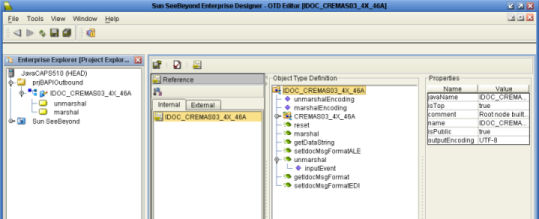
The figure above shows a CREMAS IDoc OTD in the OTD editor. The OTD has various methods which you can use in Java Collaborations for processing IDoc data. The CREMAS IDoc OTD also has marshal and unmarshal Web Service operations as seen in the Project tree. You can use these operations when using the OTD in BPM business processes.
The figure below shows the unmarshal operation in the BPM Business Process editor. You can unmarshal byte or string data onto the IDoc OTDs bytes and contents nodes respectively. The bytes node takes in only UTF-8 encoded data. That is, if you want to perform an unmarshal operation using bytes as the input source, then you must ensure that the data is in UTF-8 before utilizing this node.
In this example we are unmarshaling byte data which is not UTF-8 encoded; therefore, you must perform a bytes to text conversion in editor, and then unmarshal string data to the contents node.
Figure 3 CREMAS unmarshal

If required, you can also use the Relaunch option of the OTD to relaunch the IDoc OTD wizard and rebuild the IDoc OTD for the same IDoc Type built with a particular system release. On relaunch, the OTD is rebuilt again with the changed metadata. Any Java Collaborations and Business Processes using this IDoc OTD are also synchronized with the new changes. If your Java Collaborations or business Processes are using OTD nodes that are now absent in the relaunched OTD, you will be prompted to correct the business rules by validation errors.
The New Object Type Definition dialog box appears.
The Select metadata source page appears.
Figure 4 IDoc Wizard—Metadata Selection
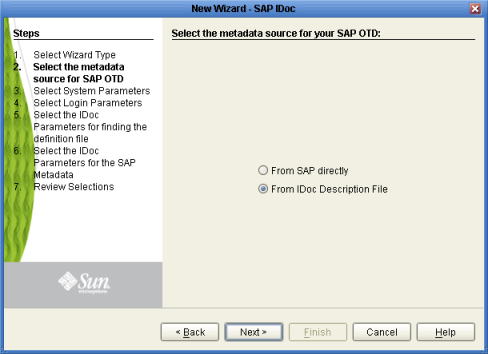
The Definition File Parameters page appears.
Figure 5 IDoc Wizard—Definition File Parameters

|
The OTD Editor window appears, displaying the OTD.
The following sections describe how to create and export the IDOC file from SAP. The procedures provided may vary depending on version and/or platform of SAP. Refer to the current documentation for your version of SAP. The procedures described in this section create the IDOC file an SAP system version 4.6 and earlier:
The SAP Easy Access window appears.
If the SAP Easy Access window does not appear, click Exit.
Figure 6 SAP Easy Access Window

The Documentation IDoc Record Types window appears.
Figure 7 Documentation IDoc Record Types Window
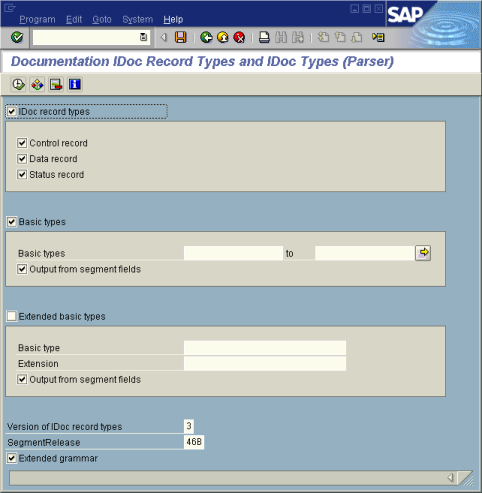
The Documentation IDoc Record Types window shows the parsed definition file.
Figure 8 Documentation IDoc Record Types Window—Parsed Definition File
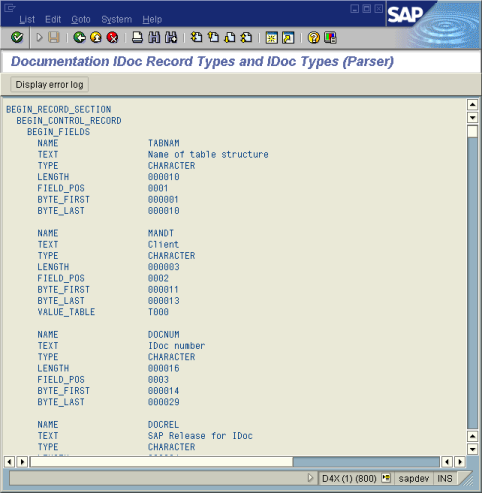
The Save List in File dialog box appears.
Figure 9 Save List in File Dialog box
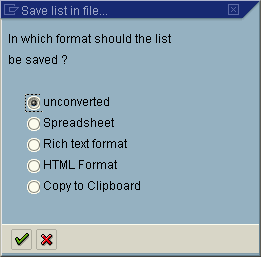
The Save As dialog box appears.
The Transfer List to a Local File dialog box displays.
Figure 10 Transfer List to a Local File Dialog Box

Once you have downloaded the IDoc description file, create the IDoc OTD using the IDoc wizard as described in Creating IDoc OTDs. Use the From Description File option so that you can select the description file you downloaded.
Follow the instructions below to download an IDoc description file from an SAP system version 4.7 and later.
Note - The images in the procedure below show the SAPGUI version 6.2 connecting to segment version 4.7.
The SAP Easy Access window appears. If the SAP Easy Access window does not display, click Exit.
Figure 11 SAP Easy Access Window
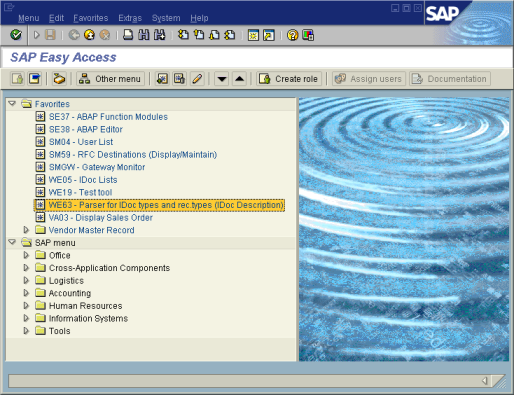
The Documentation window appears as shown below.
Figure 12 Documentation Window
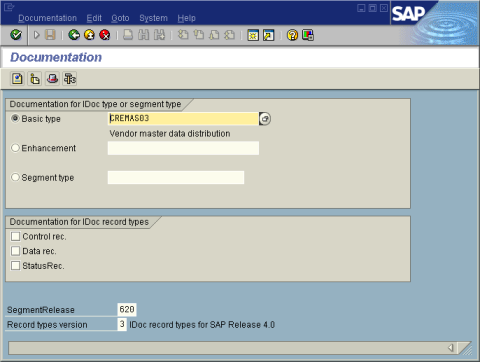
Figure 13 Documentation Window—Parsed Definition File
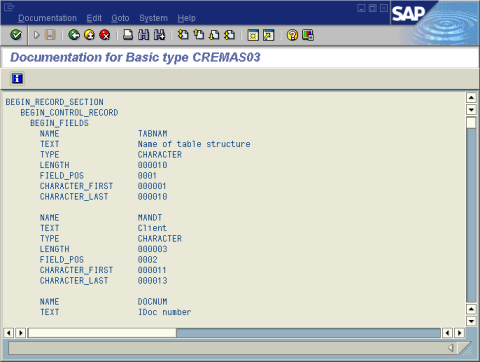
The Save List in File dialog box appears.
Figure 14 Save List in File Dialog box

The Save As dialog box appears.
Once you have saved the IDoc description file, create the IDoc OTD using the IDoc wizard. Use the From Description File option so that you can select the description file you saved.